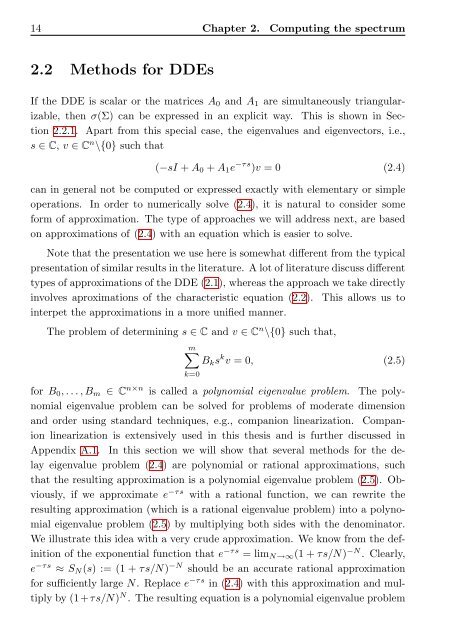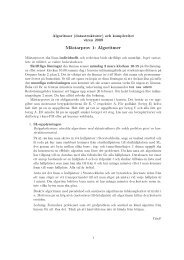The spectrum of delay-differential equations: numerical methods - KTH
The spectrum of delay-differential equations: numerical methods - KTH
The spectrum of delay-differential equations: numerical methods - KTH
You also want an ePaper? Increase the reach of your titles
YUMPU automatically turns print PDFs into web optimized ePapers that Google loves.
14 Chapter 2. Computing the <strong>spectrum</strong><br />
2.2 Methods for DDEs<br />
If the DDE is scalar or the matrices A0 and A1 are simultaneously triangularizable,<br />
then σ(Σ) can be expressed in an explicit way. This is shown in Section<br />
2.2.1. Apart from this special case, the eigenvalues and eigenvectors, i.e.,<br />
s ∈ C, v ∈ C n \{0} such that<br />
(−sI + A0 + A1e −τs )v = 0 (2.4)<br />
can in general not be computed or expressed exactly with elementary or simple<br />
operations. In order to <strong>numerical</strong>ly solve (2.4), it is natural to consider some<br />
form <strong>of</strong> approximation. <strong>The</strong> type <strong>of</strong> approaches we will address next, are based<br />
on approximations <strong>of</strong> (2.4) with an equation which is easier to solve.<br />
Note that the presentation we use here is somewhat different from the typical<br />
presentation <strong>of</strong> similar results in the literature. A lot <strong>of</strong> literature discuss different<br />
types <strong>of</strong> approximations <strong>of</strong> the DDE (2.1), whereas the approach we take directly<br />
involves aproximations <strong>of</strong> the characteristic equation (2.2). This allows us to<br />
interpet the approximations in a more unified manner.<br />
<strong>The</strong> problem <strong>of</strong> determining s ∈ C and v ∈ Cn \{0} such that,<br />
m�<br />
Bks k v = 0, (2.5)<br />
k=0<br />
for B0, . . . , Bm ∈ C n×n is called a polynomial eigenvalue problem. <strong>The</strong> polynomial<br />
eigenvalue problem can be solved for problems <strong>of</strong> moderate dimension<br />
and order using standard techniques, e.g., companion linearization. Companion<br />
linearization is extensively used in this thesis and is further discussed in<br />
Appendix A.1. In this section we will show that several <strong>methods</strong> for the <strong>delay</strong><br />
eigenvalue problem (2.4) are polynomial or rational approximations, such<br />
that the resulting approximation is a polynomial eigenvalue problem (2.5). Obviously,<br />
if we approximate e −τs with a rational function, we can rewrite the<br />
resulting approximation (which is a rational eigenvalue problem) into a polynomial<br />
eigenvalue problem (2.5) by multiplying both sides with the denominator.<br />
We illustrate this idea with a very crude approximation. We know from the definition<br />
<strong>of</strong> the exponential function that e −τs = limN→∞(1 + τs/N) −N . Clearly,<br />
e −τs ≈ SN(s) := (1 + τs/N) −N should be an accurate rational approximation<br />
for sufficiently large N. Replace e −τs in (2.4) with this approximation and multiply<br />
by (1+τs/N) N . <strong>The</strong> resulting equation is a polynomial eigenvalue problem

















